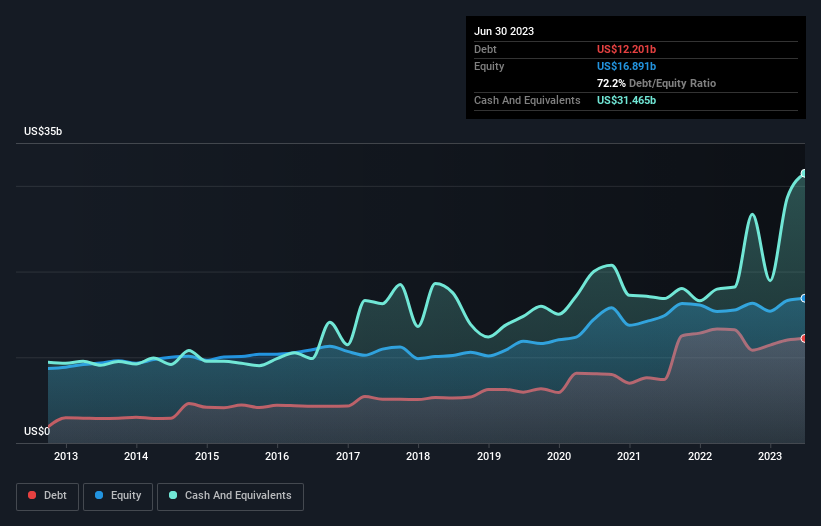Does Humana (NYSE:HUM) Have A Healthy Balance Sheet?
Howard Marks put it nicely when he said that, rather than worrying about share price volatility, 'The possibility of permanent loss is the risk I worry about... and every practical investor I know worries about.' So it seems the smart money knows that debt - which is usually involved in bankruptcies - is a very important factor, when you assess how risky a company is. We note that Humana Inc. (NYSE:HUM) does have debt on its balance sheet. But the more important question is: how much risk is that debt creating?
Why Does Debt Bring Risk?
Debt and other liabilities become risky for a business when it cannot easily fulfill those obligations, either with free cash flow or by raising capital at an attractive price. Part and parcel of capitalism is the process of 'creative destruction' where failed businesses are mercilessly liquidated by their bankers. However, a more usual (but still expensive) situation is where a company must dilute shareholders at a cheap share price simply to get debt under control. Of course, debt can be an important tool in businesses, particularly capital heavy businesses. The first thing to do when considering how much debt a business uses is to look at its cash and debt together.
See our latest analysis for Humana
How Much Debt Does Humana Carry?
As you can see below, Humana had US$12.2b of debt at June 2023, down from US$13.2b a year prior. However, it does have US$31.5b in cash offsetting this, leading to net cash of US$19.3b.
A Look At Humana's Liabilities
The latest balance sheet data shows that Humana had liabilities of US$28.3b due within a year, and liabilities of US$11.3b falling due after that. Offsetting these obligations, it had cash of US$31.5b as well as receivables valued at US$1.43b due within 12 months. So its liabilities outweigh the sum of its cash and (near-term) receivables by US$6.67b.
Of course, Humana has a titanic market capitalization of US$59.9b, so these liabilities are probably manageable. Having said that, it's clear that we should continue to monitor its balance sheet, lest it change for the worse. Despite its noteworthy liabilities, Humana boasts net cash, so it's fair to say it does not have a heavy debt load!
Fortunately, Humana grew its EBIT by 8.8% in the last year, making that debt load look even more manageable. The balance sheet is clearly the area to focus on when you are analysing debt. But ultimately the future profitability of the business will decide if Humana can strengthen its balance sheet over time. So if you're focused on the future you can check out this free report showing analyst profit forecasts.
Finally, a business needs free cash flow to pay off debt; accounting profits just don't cut it. Humana may have net cash on the balance sheet, but it is still interesting to look at how well the business converts its earnings before interest and tax (EBIT) to free cash flow, because that will influence both its need for, and its capacity to manage debt. Over the last three years, Humana actually produced more free cash flow than EBIT. That sort of strong cash conversion gets us as excited as the crowd when the beat drops at a Daft Punk concert.
Summing Up
Although Humana's balance sheet isn't particularly strong, due to the total liabilities, it is clearly positive to see that it has net cash of US$19.3b. The cherry on top was that in converted 115% of that EBIT to free cash flow, bringing in US$12b. So we don't think Humana's use of debt is risky. Another factor that would give us confidence in Humana would be if insiders have been buying shares: if you're conscious of that signal too, you can find out instantly by clicking this link.
Of course, if you're the type of investor who prefers buying stocks without the burden of debt, then don't hesitate to discover our exclusive list of net cash growth stocks, today.
Have feedback on this article? Concerned about the content? Get in touch with us directly. Alternatively, email editorial-team (at) simplywallst.com.
This article by Simply Wall St is general in nature. We provide commentary based on historical data and analyst forecasts only using an unbiased methodology and our articles are not intended to be financial advice. It does not constitute a recommendation to buy or sell any stock, and does not take account of your objectives, or your financial situation. We aim to bring you long-term focused analysis driven by fundamental data. Note that our analysis may not factor in the latest price-sensitive company announcements or qualitative material. Simply Wall St has no position in any stocks mentioned.



